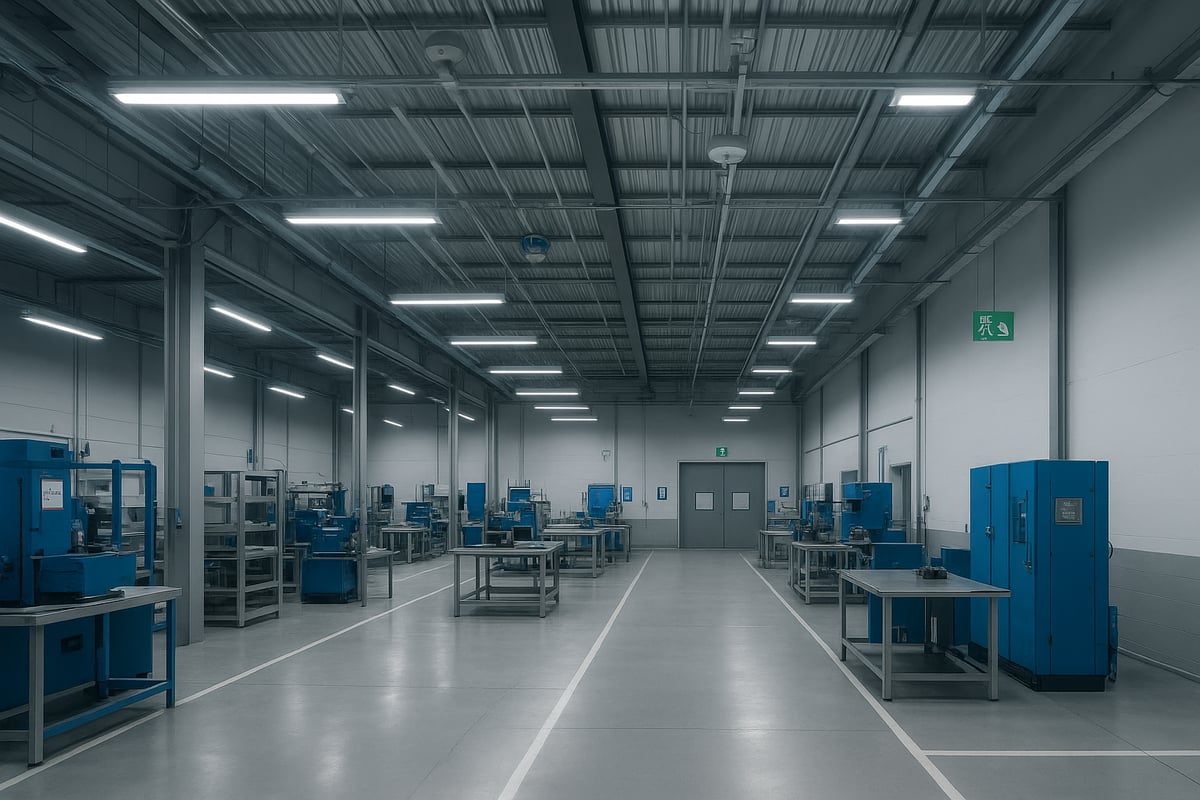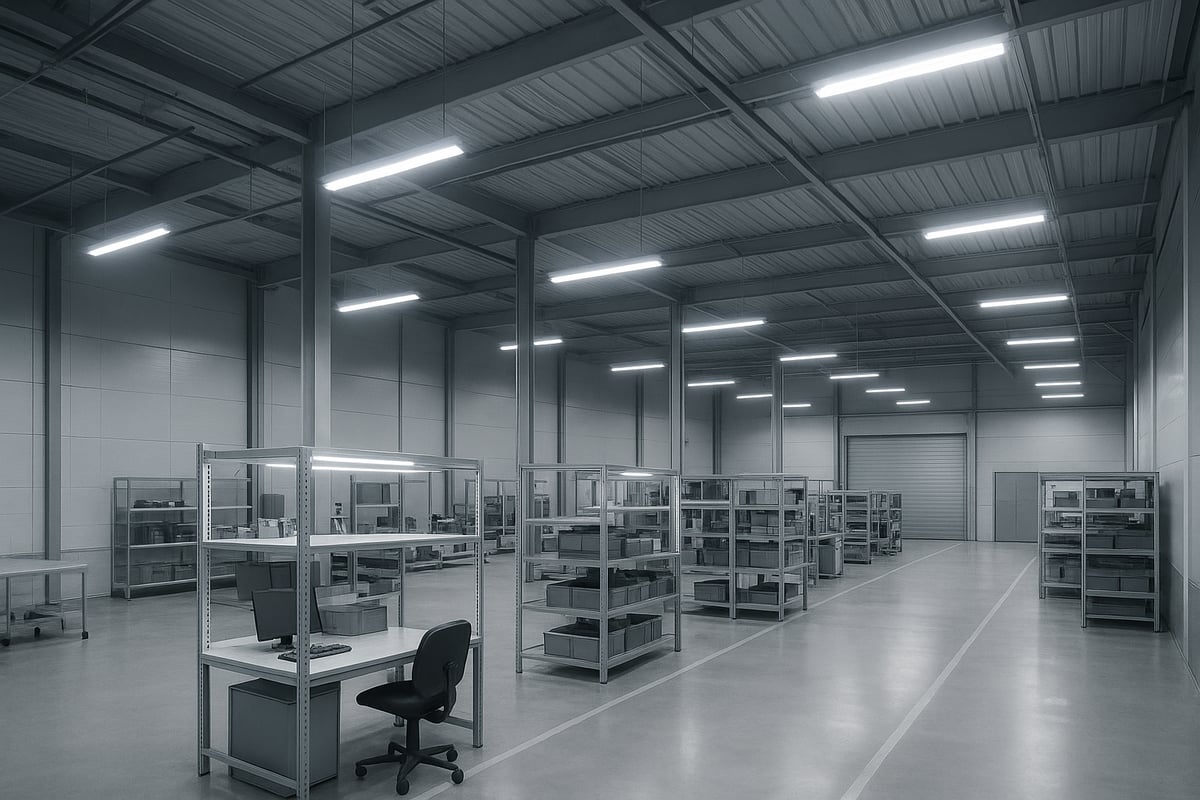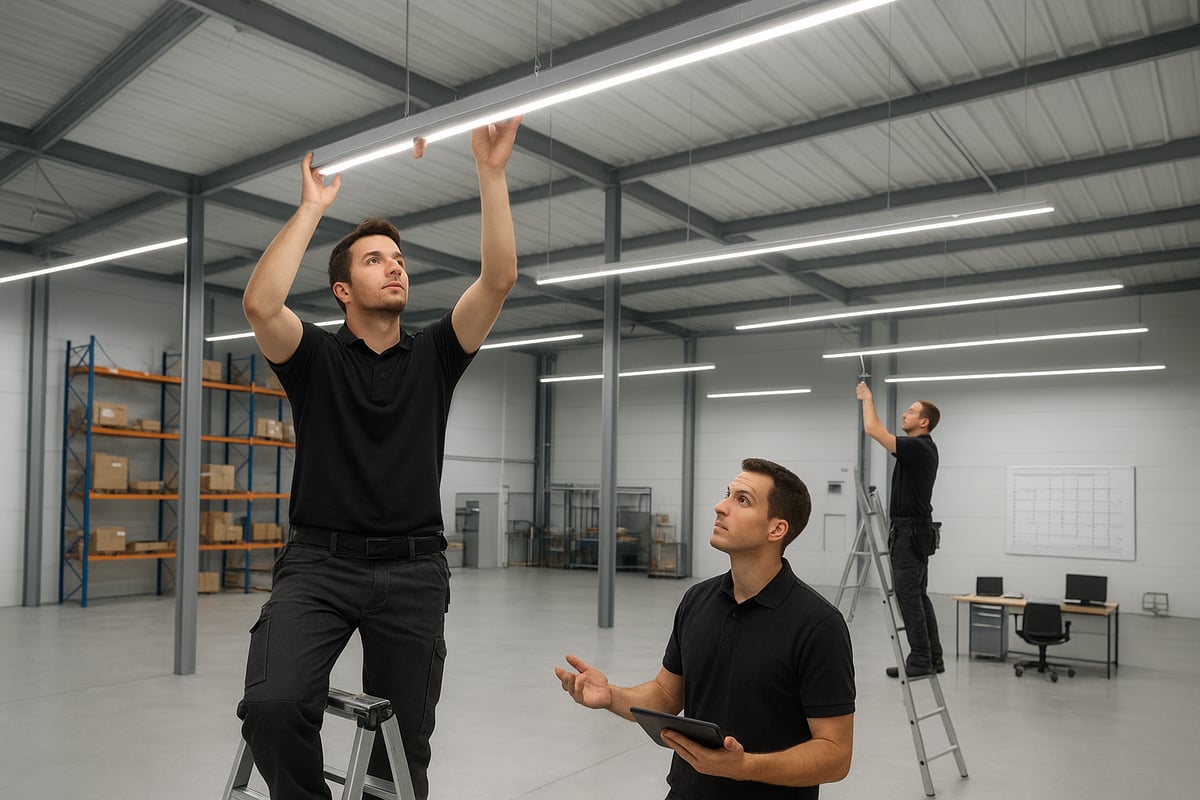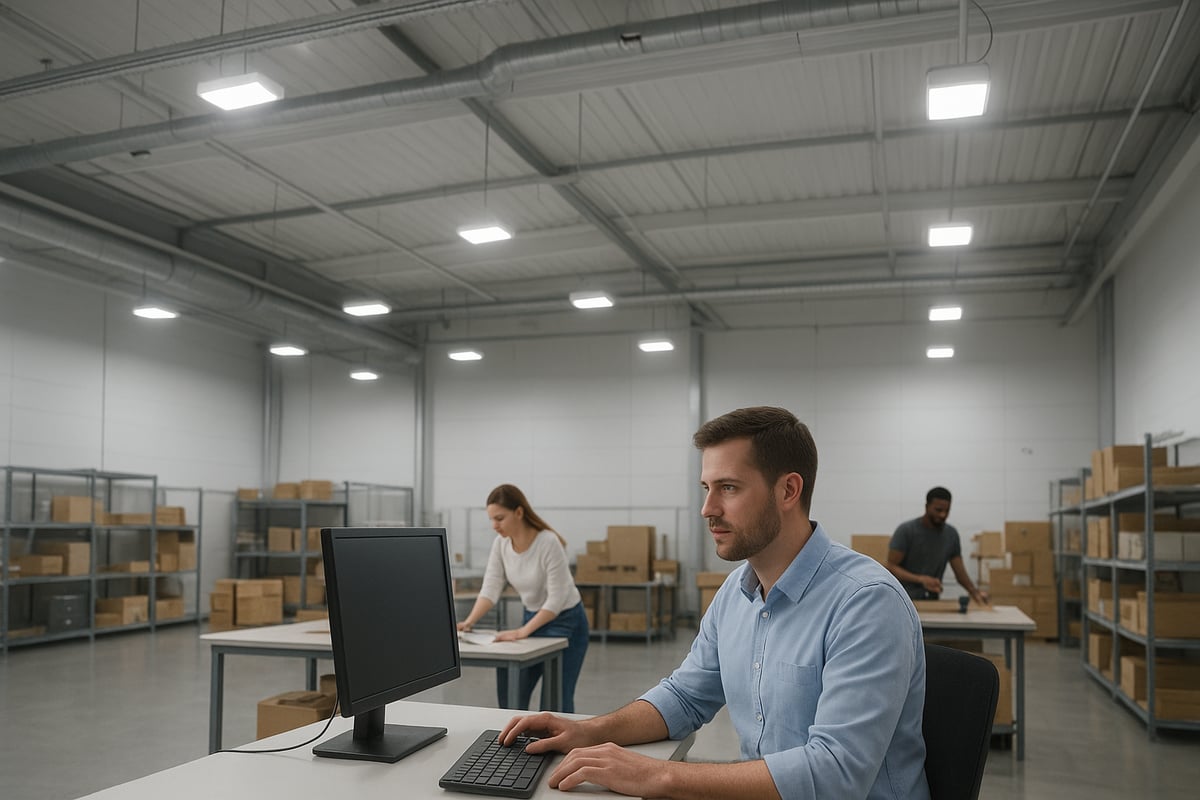By 2025, smart LED lighting business hall is essential for any business looking to save on energy, costs and invest in a safe working environment. This guide gives business owners and facility managers insight into the latest trends, technologies and choices. You'll discover the benefits of energy-efficient solutions, technical requirements, a practical roadmap for selection and implementation, and smart systems that are ready for the future. So you'll make immediately applicable choices for a sustainable, efficient and safe business hall.
Why choose LED lighting in the business hall?
The choice of LED lighting business hall is more relevant than ever. Modern companies are looking for ways to save energy, reduce costs and increase safety. LED technology offers tangible benefits in all these areas. In the following paragraphs, you'll discover why switching to LED lighting business hall is a smart investment for the future.

Energy conservation and cost reduction
LED lighting business hall saves up to 90% energy compared to conventional lighting, directly resulting in lower energy bills. Thanks to the long life of LED fixtures, up to 100,000 hours, maintenance costs are significantly lower. Entrepreneurs find that investments in LED lighting business hall pay for themselves quickly.
- Direct savings on power costs
- Fewer replacements needed, thus lower maintenance costs
- Reduction of CO2 emissions
Corporate halls that switch save thousands of dollars annually. Want to learn more about the benefits of LED lighting for commercial halls? Then read on about the impact on energy and security.
Improved work environment and safety
A bright and flicker-free LED lighting business hall creates a pleasant working atmosphere. Employees experience less fatigue and can concentrate better. The color rendering of led lighting industrial hall is excellent, with a CRI of at least 80, which is important for precise work.
- Quiet, stable light with no flicker
- Good visibility at workplaces and paths
- Extra attention to emergency exit lighting
This not only increases productivity, but also safety. A well-lit business hall significantly reduces the risk of accidents.
Sustainability and environmental friendliness
Led lighting business hall is an environmentally friendly choice. Unlike traditional lighting, LED does not contain harmful substances such as mercury. Old fixtures can often be recycled, promoting circularity.
- No toxic materials
- Less waste due to longer lifespan
- Supports CSR objectives.
Companies are demonstrating their commitment to sustainability and environmentally conscious business practices with the use of LED lighting in business premises. This is becoming increasingly important in tenders and in attracting customers.
Future-proofing and innovation
With LED lighting business hall, you choose flexibility and innovation. Smart systems such as DALI and sensors enable automation, leading to additional savings and convenience. Integration with building management systems ensures you are ready for the future.
- Automatic daylight control
- Presence sensors for efficient use
- Linking to cloud and smart building applications
Example: The Rijksmuseum switched to LED lighting business hall to reduce its carbon footprint and meet more stringent requirements.
Flexibility and customization
Led lighting industrial hall is applicable in any type of hall, from warehouse to factory. Thanks to modular fixtures and light lines, the system is easy to adapt or expand. Different lighting scenarios are possible, for example for production, cleaning or breaks.
- Solutions for every business space
- Easy to upgrade and maintain
- Light settings adjustable by zone
This flexibility makes led lighting business hall suitable for both small and large companies, with always a customized solution. This way you are prepared for changing needs and new developments.
Main technical requirements for LED lighting in commercial halls
Choosing the right LED lighting industrial hall requires attention to specific technical requirements. These requirements determine whether the lighting is not only energy-efficient and durable, but also suitable for daily practice in an industrial environment. By investing in high-quality LED solutions, you comply with legislation, reduce costs and increase working comfort.

Brightness, color and standardization
One of the most important technical requirements for LED lighting business hall is the right light intensity. According to NEN standards, a minimum of 500 lux is required at workstations. This ensures optimal visibility and prevents fatigue. The light color of 4000K (neutral white) is recommended for a natural look and good concentration. A color rendering index (CRI) of 80 or higher ensures that colors are faithfully reproduced in the industrial hall. For more details on industrial requirements, view the Industrial LED lighting solutions at EcoBeam.
| Requirements | Minimum value |
|---|---|
| Lux at workplace | 500 |
| Light color (Kelvin) | 4000K |
| CRI | ≥ 80 |
Efficiency and longevity
Efficiency plays a major role when choosing LED lighting business hall. Luminaires must deliver at least 110 lumens per watt to meet current standards and achieve low energy consumption. The lifespan of modern LED systems can reach 100,000 burning hours, making replacements rare and reducing maintenance costs. This makes the system future-proof and sustainable.
By choosing efficient fixtures, you quickly achieve significant energy savings. Thanks to the long service life, the investment also pays for itself quickly.
Consistency and comfort
For a pleasant and safe working environment, color consistency between fixtures is essential. Led lighting business hall should have a maximum of 3 SDCM (Standard Deviation of Colour Matching), so that all lamps emit the same color temperature. In addition, flicker (light flicker) is very important: a value below 15% prevents eye fatigue and increases comfort.
Note: Do not choose low-quality retrofit bulbs, as they often do not meet comfort requirements and can cause health problems.
Protection from dust, moisture and impact
Industrial halls are often dusty or damp, so luminaires should be at least IP54 rated. In production areas where there is more risk of impact, an IK rating of 09 or 10 is necessary. This keeps LED lighting company hall safe and reliable even under harsh conditions.
| Application | Min. IP value | Min. IK value |
|---|---|---|
| Warehouse | IP54 | IK09 |
| Production | IP65 | IK10 |
| Shed | IP54 | IK09 |
Example cases and practical experiences
Practical experiences show that meeting technical requirements directly contributes to comfort and safety. For example, when installing LED lighting in laboratories and distribution centers, Lumeco not only realized energy savings but also a better work experience. DSM Zwolle deliberately chose sustainable lighting as part of their CSR policy.
These examples show that attention to technical detail pays off, both in the short and long term.
Smart sensors and automation
The latest generation of LED lighting business hall is often equipped with smart sensors. Presence detection and daylight control ensure that lights are on only when needed, further extending their lifespan. CLO (Constant Light Output) technology keeps light output constant even after years of use.
Benefits of smart automation:
- Less energy consumption
- Longer life of fixtures
- Optimal light conditions at all times
This way, you invest not only in lighting, but in a complete future-proof system.
Roadmap: this is how to make smart choices for LED business hall lighting in 2025
A thoughtful approach is essential to get the most out of led lighting business hall. This roadmap will help you work in a structured way and make informed decisions. This way, you benefit from maximum energy savings, a safe working environment and a future-proof system.

Step 1: Take stock of the current situation
Start with a thorough inventory of the existing situation in the business hall. Look at the current type of lighting, energy consumption, light output per zone and maintenance costs.
Note where lighting is deficient, such as in dark corners or near emergency exits. It is wise to hire a specialist for a free lighting analysis. This will give you insight into the savings potential of LED lighting business hall.
In addition, map all zones: warehouse, production, shipping and logistics areas. Each zone requires its own approach and light level. By carrying out this step carefully, you lay the foundation for a successful transition to LED lighting company hall.
Step 2: Define the technical and functional requirements
Determine the technical requirements for each zone. Consider the required lux value, color temperature (often 4000K for neutral white light) and color rendering index (CRI ≥80).
Also check for specific requirements for dust and moisture protection (IP rating), impact resistance (IK rating) or HACCP requirements in food environments.
Some areas benefit from dimmable lighting or adjustable color temperature. By determining these requirements in advance, you avoid disappointment when implementing led lighting business hall. This will ensure that your investment matches work processes and safety requirements.
Step 3: Choose between retrofit, conversion or new system
Now that you know the requirements, decide whether to go with retrofit, conversion or a completely new system. Retrofit means fitting existing fixtures with LED modules, but this only works if the fixtures meet the technical requirements.
When converting, you use existing light lines or rails, which reduces costs and waste. A completely new LED lighting business hall light line system offers maximum efficiency, flexibility and future-proofing.
Make a trade-off based on the condition of the current system, the desired energy label and the payback period. Also consider the possibility of expansion in the future.
Step 4: Select smart options and automation
For maximum savings and comfort, it's smart to choose automation. Consider presence sensors, daylight control and light management systems (such as DALI or cloud solutions).
These systems ensure that led lighting business hall only burns where and when it is needed. You can also set different lighting scenarios by process, such as production, cleaning or break.
Consider integration with building management systems for central control and monitoring. With smart options, you'll get more out of your investment and be prepared for future innovations.
Step 5: Create a lighting plan and calculation
A professional lighting plan is indispensable for optimal results. It calculates exactly how many fixtures are needed, where they should be placed and what light intensity is required per zone.
Use simulations to visualize coverage and security. This prevents dark spots or overexposure in the business hall. The lighting plan also shows the expected energy savings when switching to LED lighting business hall.
Always have the lighting plan checked by an independent specialist. This prevents mistakes and ensures a future-proof design.
Step 6: Implementation and installation
Choose a certified installer who has experience with led lighting business hall. Expert installation ensures safety and reliability.
Have old fixtures recycled responsibly. Test the new system carefully, including the operation of sensors and scenarios. Involve employees in commissioning so they can make the best use of the new lighting.
After installation, evaluate whether everything works as desired and if the goals were met.
Step 7: Monitoring, maintenance and optimization
After installation, the process of monitoring and maintenance begins. Use the lighting management system to track energy consumption and performance.
Schedule periodic inspections and software updates for smart systems. This keeps the LED lighting business hall performing optimally and allows you to expand or adjust in a timely manner as business activities change.
Want to be completely unburdened? Then consider a partner who specializes in LED lighting for businesses For guidance from analysis to aftercare.
The benefits of smart light management systems and sensors
In 2025, smart light management systems and sensors will be an integral part of a modern LED lighting company hall. With these technologies, you get the most out of your investment, save substantially on energy costs and increase safety and comfort on the shop floor. So what makes these smart systems so powerful for any industrial hall?

Maximum energy savings and automation
A smart LED lighting business hall offers unprecedented energy savings. Through automatic dimming, daylight control and presence sensors, lighting is lit only where and when needed. The system continuously adjusts to natural light and occupancy. This prevents unnecessary power consumption and can increase energy savings by as much as 90%.
- Automatic shutdown in unused zones
- Daylight-based dimming
- Direct reduction in energy bills
The combination of smart control and economical LED fixtures makes the business hall future-proof and sustainable.
Increased longevity and lower maintenance costs
The smart switching of LED lighting business hall reduces the number of on and off switching moments. This significantly extends the lifespan of the fixtures. Less wear and tear means lower maintenance costs and less disruption to the business process.
- Predictable maintenance through monitoring
- Longer service life due to fewer switching moments
- Lower replacement and repair costs
Regular reports allow maintenance to be scheduled in a timely manner, preventing unexpected failures.
Flexibility and personalization
Smart systems make it easy to adapt the LED lighting business hall to different situations. Each zone gets its own lighting scenario, tailored to the work process. Think brighter light during production, softer light during cleaning or break time.
- Adjustable lighting scenarios per zone
- Personal adjustments via control tablets
- Easy expansion or modification of settings
This flexibility increases working comfort and ensures optimal productivity in any operating space.
Integration and data collection
A modern LED lighting business hall is often linked to building management systems. Through BACnet or cloud platforms, central control and monitoring becomes possible. Thus, data on energy consumption, occupancy and light levels can be collected and analyzed.
This provides valuable insights for further optimization and reporting. Want to know more about these smart capabilities? Check out the smart LED lighting systems for an overview of the latest features and integrations.
Future-proof and scalable
Smart lighting management systems are designed to grow with your business. New technologies such as IoT and AI can be easily added to the existing LED lighting business hall. This makes the system ready for stricter sustainability standards and future legislation.
- Expandable with additional sensors or software
- Ready for more stringent energy reporting
- Investment remains relevant and valuable
This scalability ensures that the lighting always matches the changing demands of the organization.
Practice
Several organizations have already made the move to smart LED lighting business hall. For example, Plantion realized better product presentation and higher employee satisfaction. Wageningen University replaced 1,300 lamps and saved substantially on maintenance and energy.
These examples show that the combination of smart systems and LED leads to measurable results in terms of cost, comfort and sustainability.
Practical tips and common mistakes with LED lighting in commercial halls
Choosing and implementing LED lighting business hall requires attention to detail and a structured approach. Many companies underestimate the importance of a good lighting plan and the right technical choices. In this section we discuss common mistakes, give practical tips and explain relevant regulations and maintenance. In this way you can avoid costly mistakes and get the most out of LED lighting for your business hall.
Common pitfalls
When switching to LED lighting business hall, the same mistakes are often made. Some major pitfalls are:
- Insufficient attention to technical requirements such as lux, CRI, SDCM and IP/IK rating.
- Lack of a professional lighting calculation, leading to dark areas or just overexposure.
- Wrong choice for retrofit, with old fixtures found to be unsuitable for LED.
- No allowance for future maintenance or expansion after installation.
These mistakes cause unnecessary costs, decreased safety and lower job satisfaction. Recognizing these points will help you avoid problems with led lighting business hall.
Tips for successful implementation
A successful implementation of LED lighting business hall starts with a good plan. Follow these tips:
- Always have a professional lighting plan prepared by a specialist.
- Choose modular systems with replaceable components.
- Integrate smart sensors for presence and daylight for maximum savings.
- Ask vendors for references and real-world examples of similar projects.
For more guidelines on energy-efficient lighting and technical requirements, please see the advice of energy-efficient business lighting consult. This way you can be sure of a sustainable and future-proof led lighting business hall.
Relevant laws and regulations for 2025
The requirements around LED lighting business hall are changing rapidly. Starting in 2025, stricter energy standards and reporting requirements apply to businesses. Consider:
- Requirements around minimum energy performance of lighting.
- Grants and tax breaks for sustainable investments.
- Tightening requirements for circular and corporate social responsibility.
Keep up to date with developments and get advice on current regulations. This way, your led lighting industrial hall will meet all requirements and you will enjoy financial benefits.
Maintenance and aftercare
Proper maintenance is essential for the life and performance of LED lighting business hall. Schedule periodic inspections and monitoring. This will prevent breakdowns and ensure continued energy savings.
Pay attention to software updates in smart systems and keep documentation of the system current. This keeps you flexible for future expansions or changes in use of the facility. A well-maintained system minimizes costs and ensures safety.
Practical examples
Case studies show how companies benefit from LED lighting business hall. For example, the Radboud University realized large energy savings with minimal inconvenience during replacement. Municipalities are increasingly choosing CSR and circularity as selection criteria.
The benefits are also evident in distribution centers and warehouses. For example, take a look at the solutions for LED lighting warehouse and shed for inspiring case studies and practical applications. These examples demonstrate the importance of a thoughtful approach.
Checklist for the right choice
Use the checklist below when purchasing and implementing led lighting business hall:
- Has a professional lighting plan been created?
- Do luminaires meet appropriate standards (lux, CRI, IP, IK)?
- Are smart sensors and automation integrated?
- Is the system modular and future-proof?
- Is maintenance and monitoring secured?
- Have you requested references and case studies?
Always be guided by an experienced partner for the best results. This way you are assured of optimal LED lighting business hall.
Now that you know exactly what to look for in LED lighting for your commercial building and which smart choices will make the difference in 2025, it makes sense to take the next step. Every building and every work environment requires its own approach, and we're happy to think along with you. Do you want to be sure you find the right balance between energy savings, comfort and future-proofing? Then schedule a non-binding consultation with a specialist who will help you find the best solution for your situation. Together we will ensure a clear, safe and sustainable workplace.
Schedule a consultation

